Business Ethics and CSR: Aboriginal People in Australia Report
VerifiedAdded on 2020/03/16
|8
|2350
|147
Report
AI Summary
This report provides a comprehensive overview of the ethical and corporate social responsibility (CSR) considerations for businesses operating in Australia, specifically concerning the Aboriginal population. It begins with a historical background of the Aboriginal people, detailing the impact of British colonization, land dispossession, and the resulting social and cultural challenges. The report then examines the current legal and regulatory framework in place to protect Aboriginal rights and culture, including acts like the Northern Territory National Emergency Response Act 2007 and the Aboriginal Land Council Elections Act 2004. It also highlights the Australian government's support for the Declaration of the Rights of Indigenous Peoples. The core of the report focuses on the ethical responsibilities of businesses, emphasizing the importance of respecting Aboriginal culture, using appropriate language, promoting employment opportunities, and avoiding cultural bias. Finally, the report offers recommendations for businesses to improve their ethical standards, promote environmental sustainability, and foster respectful communication with Aboriginal communities. The report underscores the significance of integrating ethical considerations into business practices to ensure the well-being and rights of the Aboriginal people and the sustainability of the environment.
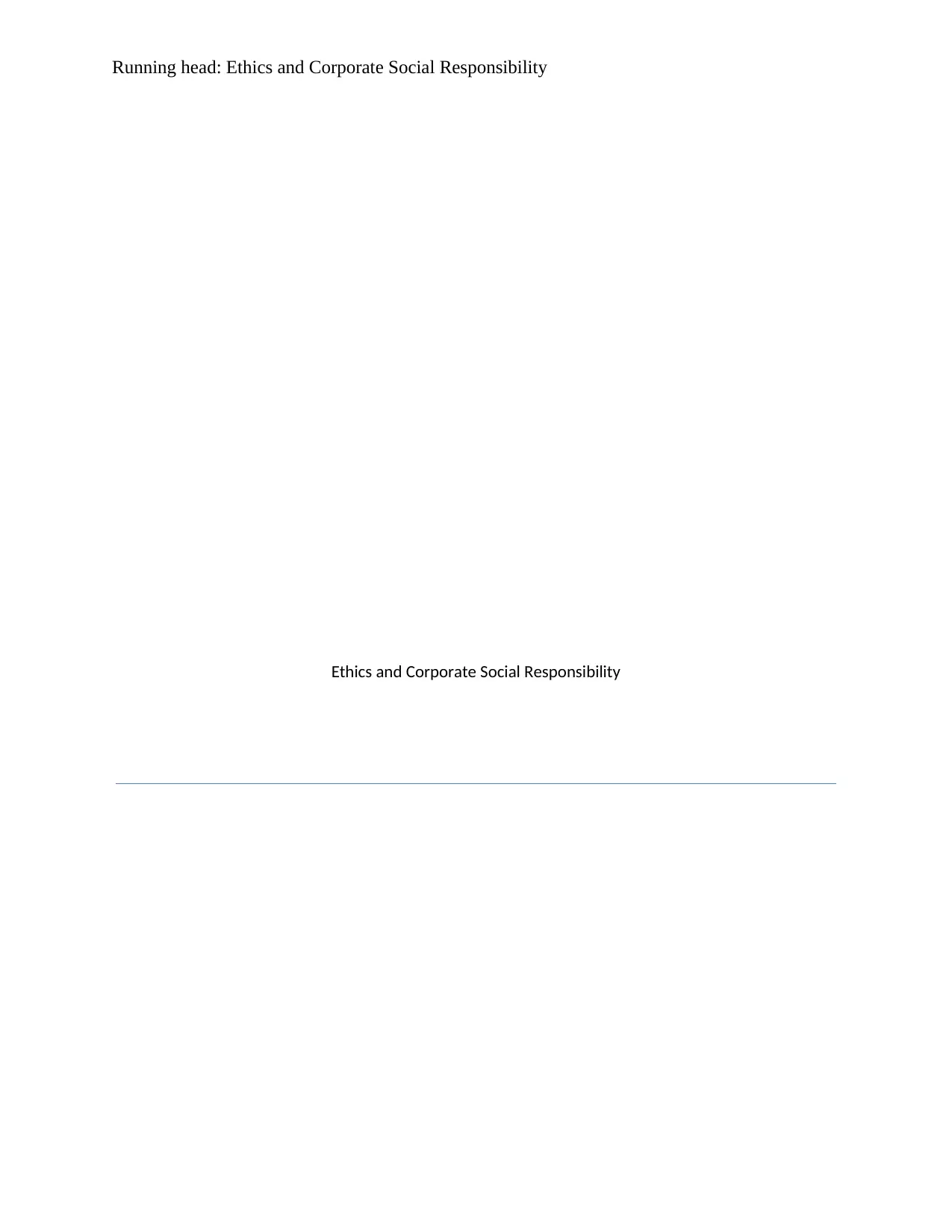
Running head: Ethics and Corporate Social Responsibility
Ethics and Corporate Social Responsibility
Ethics and Corporate Social Responsibility
Paraphrase This Document
Need a fresh take? Get an instant paraphrase of this document with our AI Paraphraser
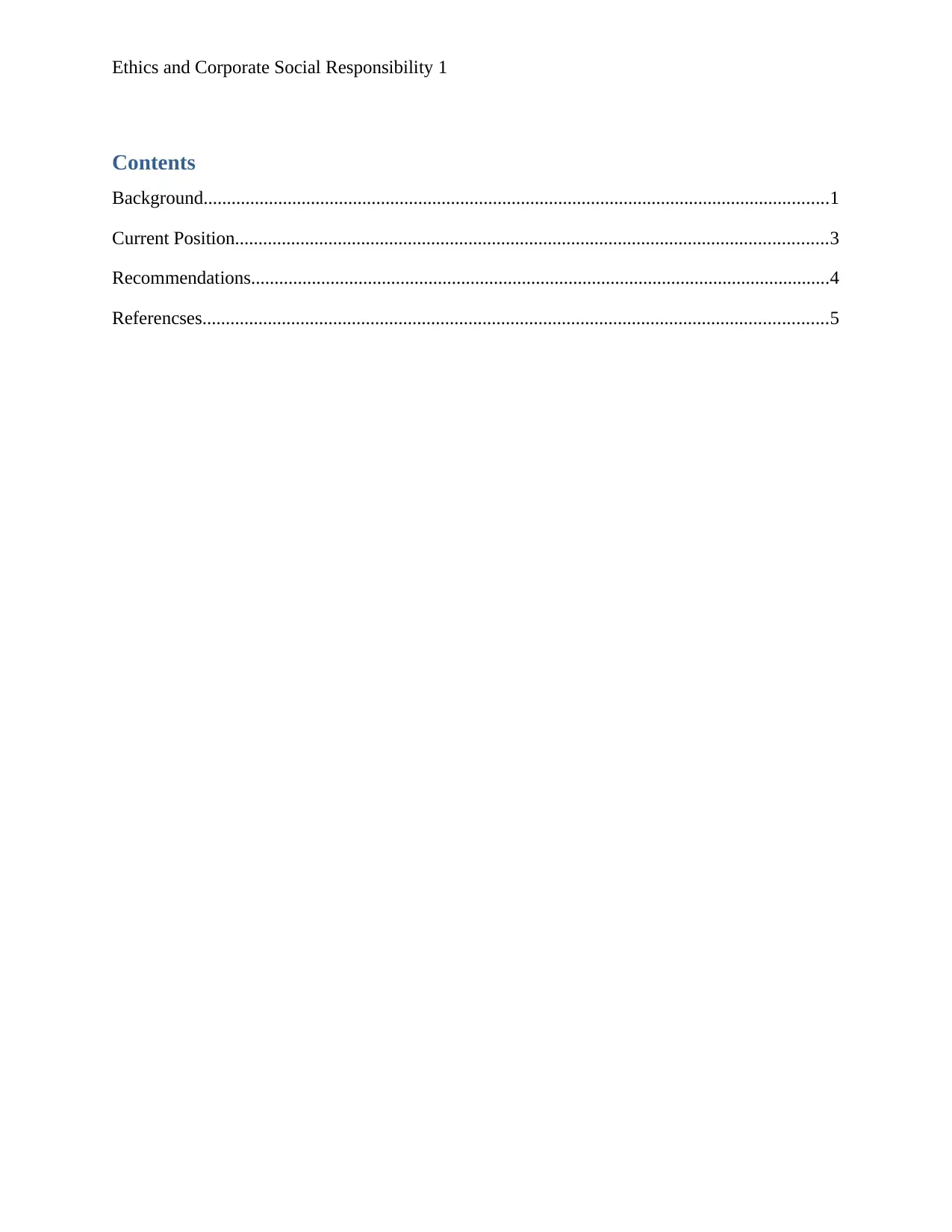
Ethics and Corporate Social Responsibility 1
Contents
Background......................................................................................................................................1
Current Position...............................................................................................................................3
Recommendations............................................................................................................................4
Referencses......................................................................................................................................5
Contents
Background......................................................................................................................................1
Current Position...............................................................................................................................3
Recommendations............................................................................................................................4
Referencses......................................................................................................................................5
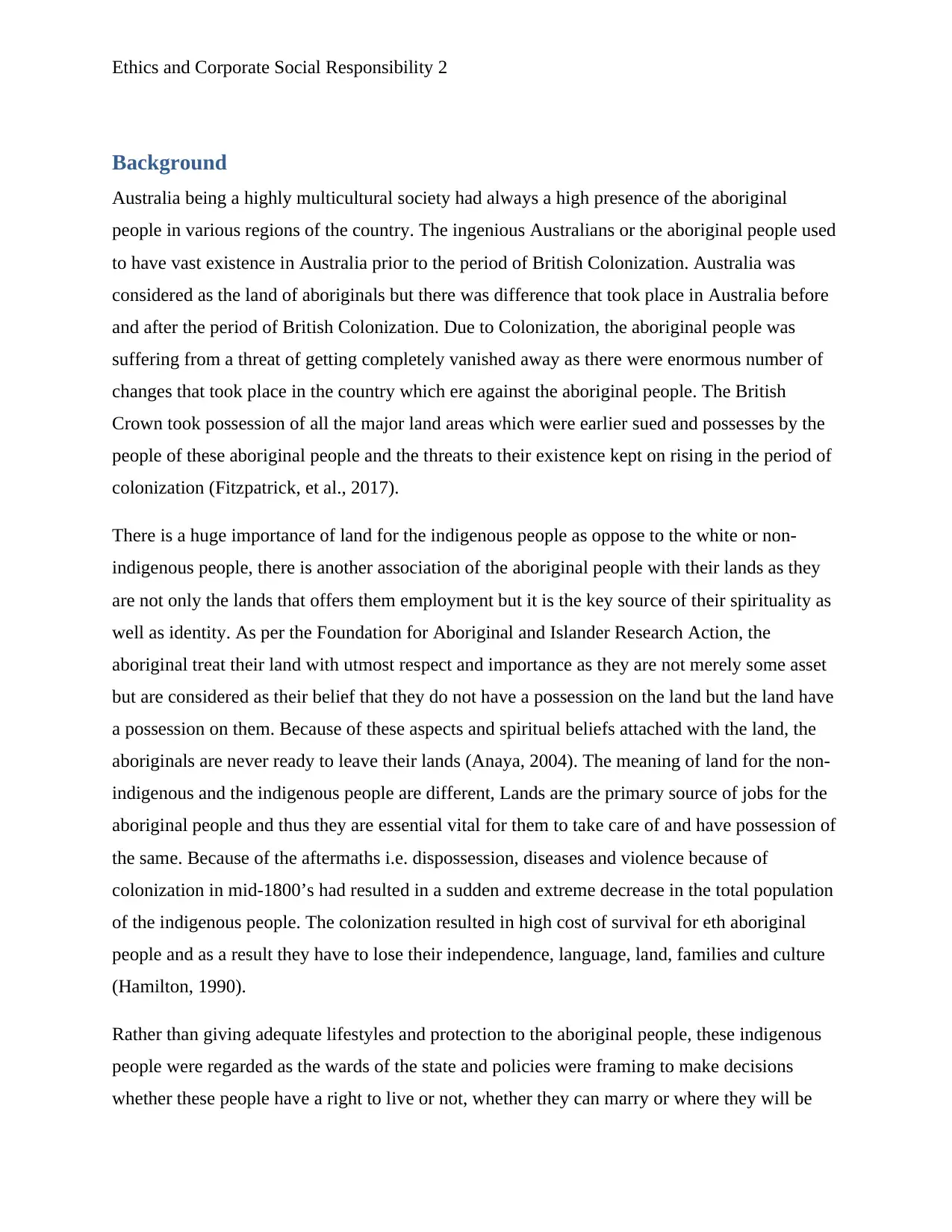
Ethics and Corporate Social Responsibility 2
Background
Australia being a highly multicultural society had always a high presence of the aboriginal
people in various regions of the country. The ingenious Australians or the aboriginal people used
to have vast existence in Australia prior to the period of British Colonization. Australia was
considered as the land of aboriginals but there was difference that took place in Australia before
and after the period of British Colonization. Due to Colonization, the aboriginal people was
suffering from a threat of getting completely vanished away as there were enormous number of
changes that took place in the country which ere against the aboriginal people. The British
Crown took possession of all the major land areas which were earlier sued and possesses by the
people of these aboriginal people and the threats to their existence kept on rising in the period of
colonization (Fitzpatrick, et al., 2017).
There is a huge importance of land for the indigenous people as oppose to the white or non-
indigenous people, there is another association of the aboriginal people with their lands as they
are not only the lands that offers them employment but it is the key source of their spirituality as
well as identity. As per the Foundation for Aboriginal and Islander Research Action, the
aboriginal treat their land with utmost respect and importance as they are not merely some asset
but are considered as their belief that they do not have a possession on the land but the land have
a possession on them. Because of these aspects and spiritual beliefs attached with the land, the
aboriginals are never ready to leave their lands (Anaya, 2004). The meaning of land for the non-
indigenous and the indigenous people are different, Lands are the primary source of jobs for the
aboriginal people and thus they are essential vital for them to take care of and have possession of
the same. Because of the aftermaths i.e. dispossession, diseases and violence because of
colonization in mid-1800’s had resulted in a sudden and extreme decrease in the total population
of the indigenous people. The colonization resulted in high cost of survival for eth aboriginal
people and as a result they have to lose their independence, language, land, families and culture
(Hamilton, 1990).
Rather than giving adequate lifestyles and protection to the aboriginal people, these indigenous
people were regarded as the wards of the state and policies were framing to make decisions
whether these people have a right to live or not, whether they can marry or where they will be
Background
Australia being a highly multicultural society had always a high presence of the aboriginal
people in various regions of the country. The ingenious Australians or the aboriginal people used
to have vast existence in Australia prior to the period of British Colonization. Australia was
considered as the land of aboriginals but there was difference that took place in Australia before
and after the period of British Colonization. Due to Colonization, the aboriginal people was
suffering from a threat of getting completely vanished away as there were enormous number of
changes that took place in the country which ere against the aboriginal people. The British
Crown took possession of all the major land areas which were earlier sued and possesses by the
people of these aboriginal people and the threats to their existence kept on rising in the period of
colonization (Fitzpatrick, et al., 2017).
There is a huge importance of land for the indigenous people as oppose to the white or non-
indigenous people, there is another association of the aboriginal people with their lands as they
are not only the lands that offers them employment but it is the key source of their spirituality as
well as identity. As per the Foundation for Aboriginal and Islander Research Action, the
aboriginal treat their land with utmost respect and importance as they are not merely some asset
but are considered as their belief that they do not have a possession on the land but the land have
a possession on them. Because of these aspects and spiritual beliefs attached with the land, the
aboriginals are never ready to leave their lands (Anaya, 2004). The meaning of land for the non-
indigenous and the indigenous people are different, Lands are the primary source of jobs for the
aboriginal people and thus they are essential vital for them to take care of and have possession of
the same. Because of the aftermaths i.e. dispossession, diseases and violence because of
colonization in mid-1800’s had resulted in a sudden and extreme decrease in the total population
of the indigenous people. The colonization resulted in high cost of survival for eth aboriginal
people and as a result they have to lose their independence, language, land, families and culture
(Hamilton, 1990).
Rather than giving adequate lifestyles and protection to the aboriginal people, these indigenous
people were regarded as the wards of the state and policies were framing to make decisions
whether these people have a right to live or not, whether they can marry or where they will be
⊘ This is a preview!⊘
Do you want full access?
Subscribe today to unlock all pages.

Trusted by 1+ million students worldwide
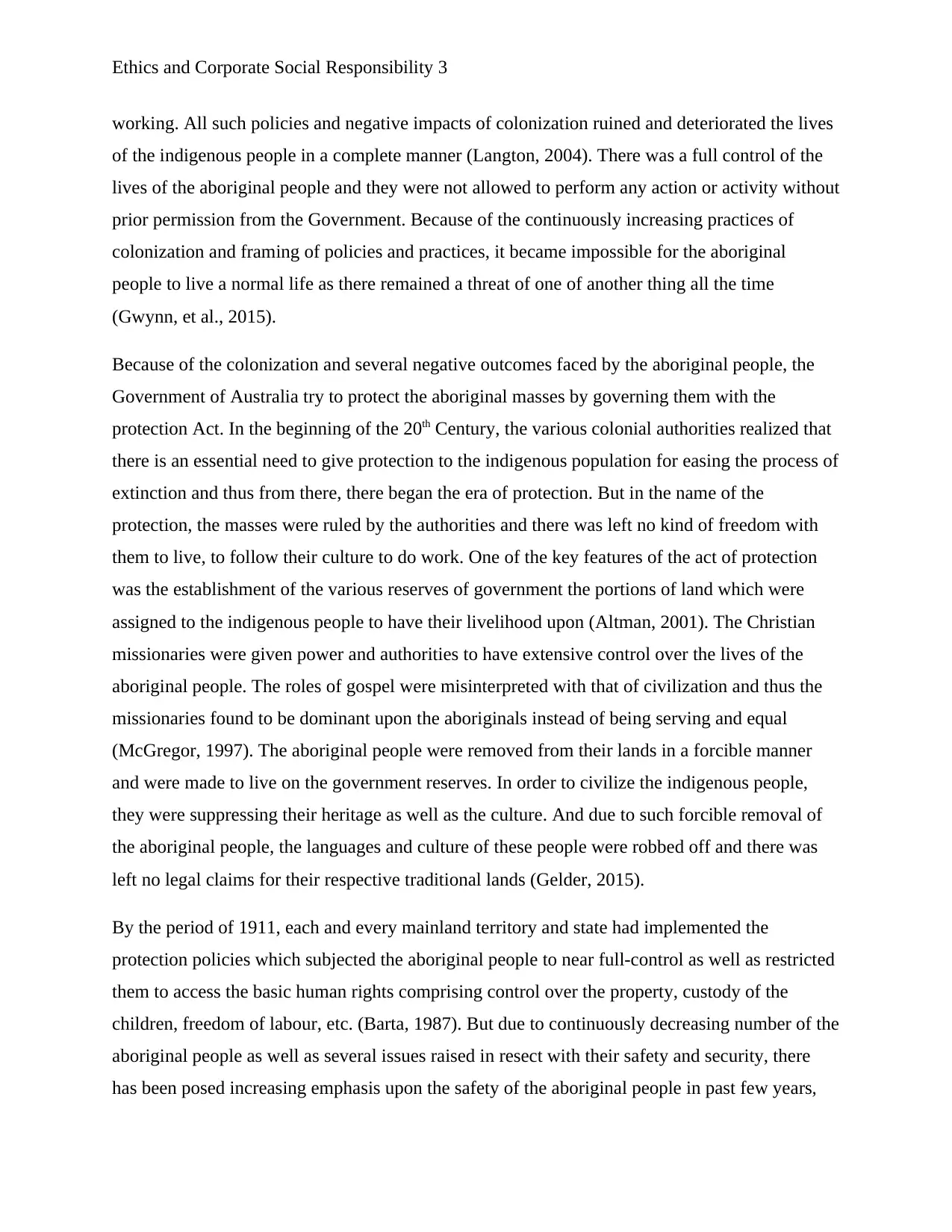
Ethics and Corporate Social Responsibility 3
working. All such policies and negative impacts of colonization ruined and deteriorated the lives
of the indigenous people in a complete manner (Langton, 2004). There was a full control of the
lives of the aboriginal people and they were not allowed to perform any action or activity without
prior permission from the Government. Because of the continuously increasing practices of
colonization and framing of policies and practices, it became impossible for the aboriginal
people to live a normal life as there remained a threat of one of another thing all the time
(Gwynn, et al., 2015).
Because of the colonization and several negative outcomes faced by the aboriginal people, the
Government of Australia try to protect the aboriginal masses by governing them with the
protection Act. In the beginning of the 20th Century, the various colonial authorities realized that
there is an essential need to give protection to the indigenous population for easing the process of
extinction and thus from there, there began the era of protection. But in the name of the
protection, the masses were ruled by the authorities and there was left no kind of freedom with
them to live, to follow their culture to do work. One of the key features of the act of protection
was the establishment of the various reserves of government the portions of land which were
assigned to the indigenous people to have their livelihood upon (Altman, 2001). The Christian
missionaries were given power and authorities to have extensive control over the lives of the
aboriginal people. The roles of gospel were misinterpreted with that of civilization and thus the
missionaries found to be dominant upon the aboriginals instead of being serving and equal
(McGregor, 1997). The aboriginal people were removed from their lands in a forcible manner
and were made to live on the government reserves. In order to civilize the indigenous people,
they were suppressing their heritage as well as the culture. And due to such forcible removal of
the aboriginal people, the languages and culture of these people were robbed off and there was
left no legal claims for their respective traditional lands (Gelder, 2015).
By the period of 1911, each and every mainland territory and state had implemented the
protection policies which subjected the aboriginal people to near full-control as well as restricted
them to access the basic human rights comprising control over the property, custody of the
children, freedom of labour, etc. (Barta, 1987). But due to continuously decreasing number of the
aboriginal people as well as several issues raised in resect with their safety and security, there
has been posed increasing emphasis upon the safety of the aboriginal people in past few years,
working. All such policies and negative impacts of colonization ruined and deteriorated the lives
of the indigenous people in a complete manner (Langton, 2004). There was a full control of the
lives of the aboriginal people and they were not allowed to perform any action or activity without
prior permission from the Government. Because of the continuously increasing practices of
colonization and framing of policies and practices, it became impossible for the aboriginal
people to live a normal life as there remained a threat of one of another thing all the time
(Gwynn, et al., 2015).
Because of the colonization and several negative outcomes faced by the aboriginal people, the
Government of Australia try to protect the aboriginal masses by governing them with the
protection Act. In the beginning of the 20th Century, the various colonial authorities realized that
there is an essential need to give protection to the indigenous population for easing the process of
extinction and thus from there, there began the era of protection. But in the name of the
protection, the masses were ruled by the authorities and there was left no kind of freedom with
them to live, to follow their culture to do work. One of the key features of the act of protection
was the establishment of the various reserves of government the portions of land which were
assigned to the indigenous people to have their livelihood upon (Altman, 2001). The Christian
missionaries were given power and authorities to have extensive control over the lives of the
aboriginal people. The roles of gospel were misinterpreted with that of civilization and thus the
missionaries found to be dominant upon the aboriginals instead of being serving and equal
(McGregor, 1997). The aboriginal people were removed from their lands in a forcible manner
and were made to live on the government reserves. In order to civilize the indigenous people,
they were suppressing their heritage as well as the culture. And due to such forcible removal of
the aboriginal people, the languages and culture of these people were robbed off and there was
left no legal claims for their respective traditional lands (Gelder, 2015).
By the period of 1911, each and every mainland territory and state had implemented the
protection policies which subjected the aboriginal people to near full-control as well as restricted
them to access the basic human rights comprising control over the property, custody of the
children, freedom of labour, etc. (Barta, 1987). But due to continuously decreasing number of the
aboriginal people as well as several issues raised in resect with their safety and security, there
has been posed increasing emphasis upon the safety of the aboriginal people in past few years,
Paraphrase This Document
Need a fresh take? Get an instant paraphrase of this document with our AI Paraphraser
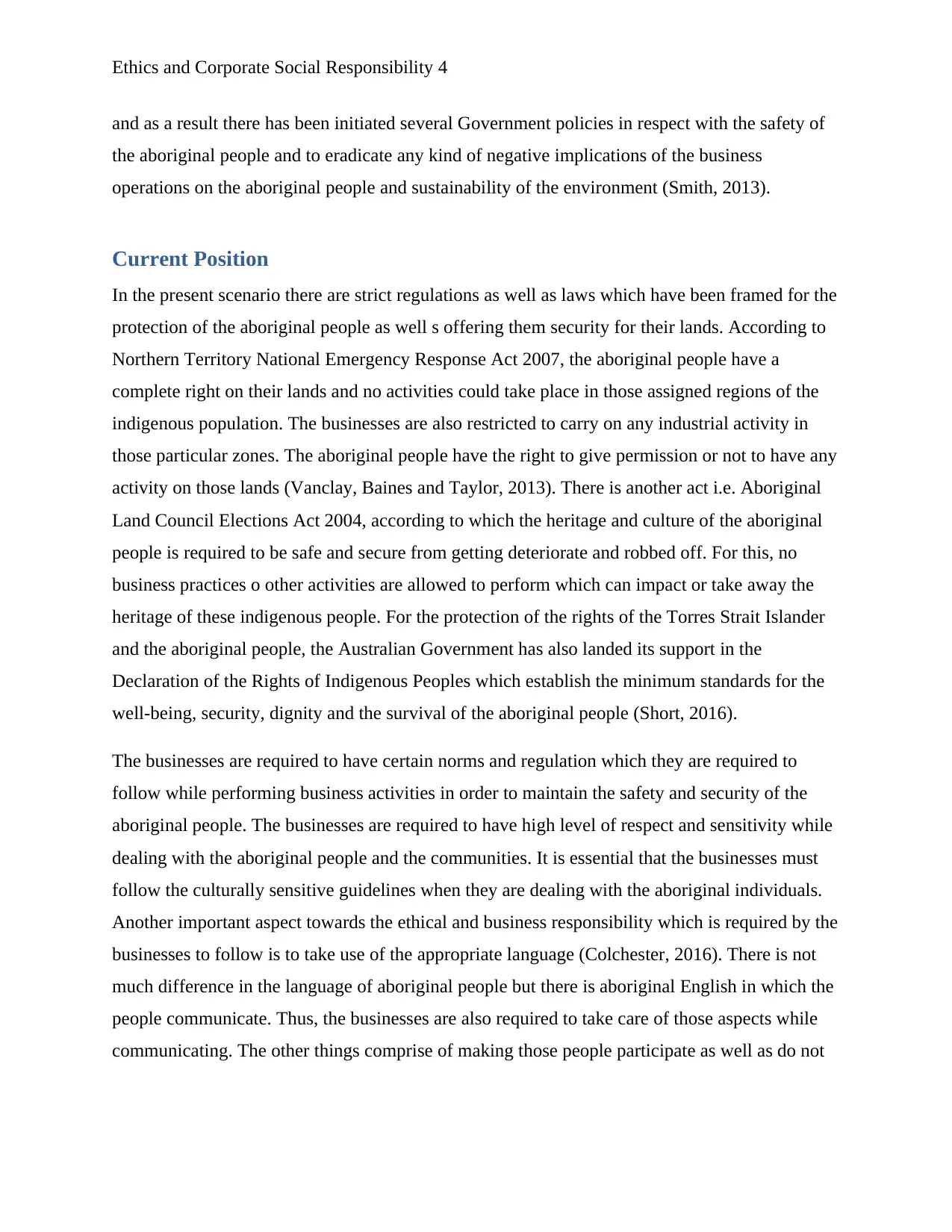
Ethics and Corporate Social Responsibility 4
and as a result there has been initiated several Government policies in respect with the safety of
the aboriginal people and to eradicate any kind of negative implications of the business
operations on the aboriginal people and sustainability of the environment (Smith, 2013).
Current Position
In the present scenario there are strict regulations as well as laws which have been framed for the
protection of the aboriginal people as well s offering them security for their lands. According to
Northern Territory National Emergency Response Act 2007, the aboriginal people have a
complete right on their lands and no activities could take place in those assigned regions of the
indigenous population. The businesses are also restricted to carry on any industrial activity in
those particular zones. The aboriginal people have the right to give permission or not to have any
activity on those lands (Vanclay, Baines and Taylor, 2013). There is another act i.e. Aboriginal
Land Council Elections Act 2004, according to which the heritage and culture of the aboriginal
people is required to be safe and secure from getting deteriorate and robbed off. For this, no
business practices o other activities are allowed to perform which can impact or take away the
heritage of these indigenous people. For the protection of the rights of the Torres Strait Islander
and the aboriginal people, the Australian Government has also landed its support in the
Declaration of the Rights of Indigenous Peoples which establish the minimum standards for the
well-being, security, dignity and the survival of the aboriginal people (Short, 2016).
The businesses are required to have certain norms and regulation which they are required to
follow while performing business activities in order to maintain the safety and security of the
aboriginal people. The businesses are required to have high level of respect and sensitivity while
dealing with the aboriginal people and the communities. It is essential that the businesses must
follow the culturally sensitive guidelines when they are dealing with the aboriginal individuals.
Another important aspect towards the ethical and business responsibility which is required by the
businesses to follow is to take use of the appropriate language (Colchester, 2016). There is not
much difference in the language of aboriginal people but there is aboriginal English in which the
people communicate. Thus, the businesses are also required to take care of those aspects while
communicating. The other things comprise of making those people participate as well as do not
and as a result there has been initiated several Government policies in respect with the safety of
the aboriginal people and to eradicate any kind of negative implications of the business
operations on the aboriginal people and sustainability of the environment (Smith, 2013).
Current Position
In the present scenario there are strict regulations as well as laws which have been framed for the
protection of the aboriginal people as well s offering them security for their lands. According to
Northern Territory National Emergency Response Act 2007, the aboriginal people have a
complete right on their lands and no activities could take place in those assigned regions of the
indigenous population. The businesses are also restricted to carry on any industrial activity in
those particular zones. The aboriginal people have the right to give permission or not to have any
activity on those lands (Vanclay, Baines and Taylor, 2013). There is another act i.e. Aboriginal
Land Council Elections Act 2004, according to which the heritage and culture of the aboriginal
people is required to be safe and secure from getting deteriorate and robbed off. For this, no
business practices o other activities are allowed to perform which can impact or take away the
heritage of these indigenous people. For the protection of the rights of the Torres Strait Islander
and the aboriginal people, the Australian Government has also landed its support in the
Declaration of the Rights of Indigenous Peoples which establish the minimum standards for the
well-being, security, dignity and the survival of the aboriginal people (Short, 2016).
The businesses are required to have certain norms and regulation which they are required to
follow while performing business activities in order to maintain the safety and security of the
aboriginal people. The businesses are required to have high level of respect and sensitivity while
dealing with the aboriginal people and the communities. It is essential that the businesses must
follow the culturally sensitive guidelines when they are dealing with the aboriginal individuals.
Another important aspect towards the ethical and business responsibility which is required by the
businesses to follow is to take use of the appropriate language (Colchester, 2016). There is not
much difference in the language of aboriginal people but there is aboriginal English in which the
people communicate. Thus, the businesses are also required to take care of those aspects while
communicating. The other things comprise of making those people participate as well as do not
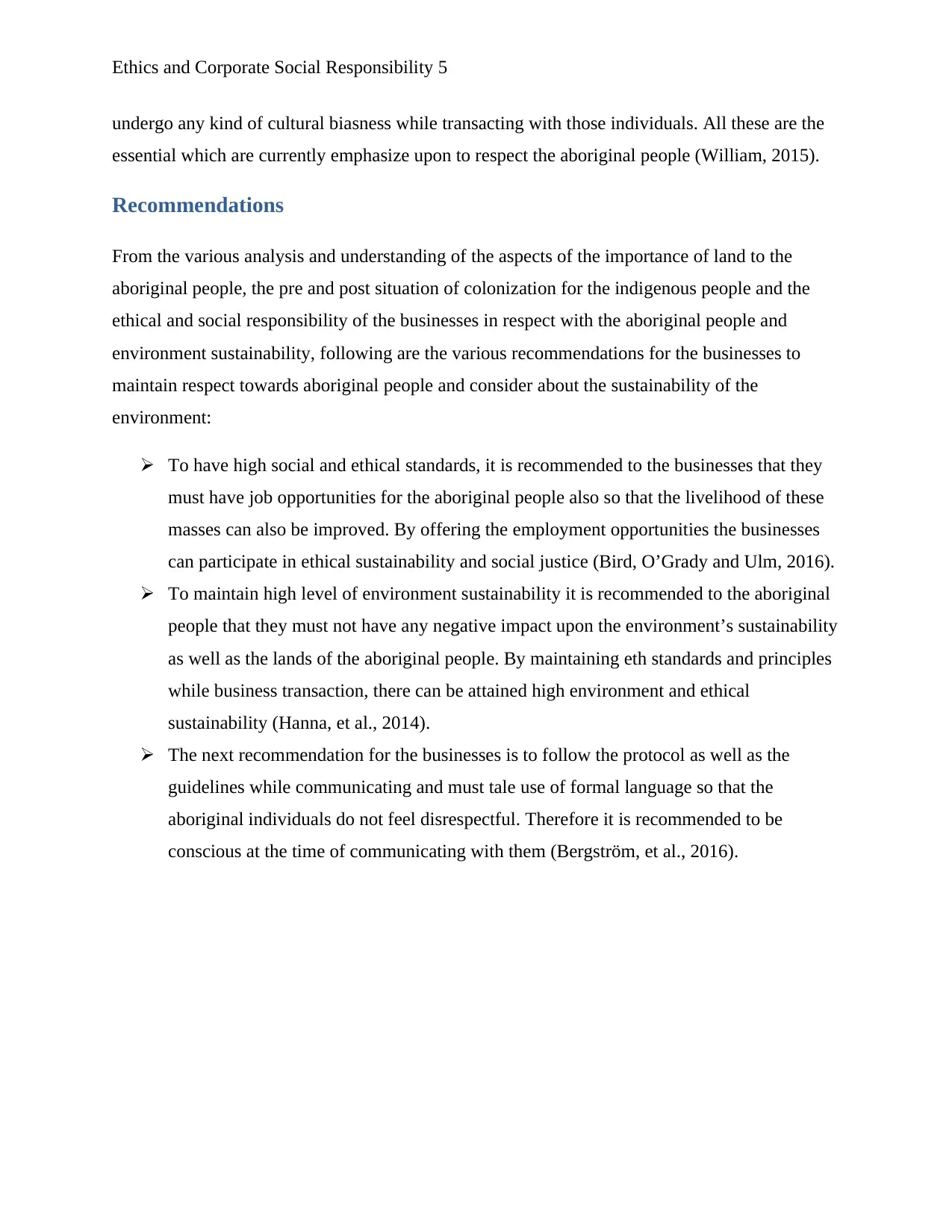
Ethics and Corporate Social Responsibility 5
undergo any kind of cultural biasness while transacting with those individuals. All these are the
essential which are currently emphasize upon to respect the aboriginal people (William, 2015).
Recommendations
From the various analysis and understanding of the aspects of the importance of land to the
aboriginal people, the pre and post situation of colonization for the indigenous people and the
ethical and social responsibility of the businesses in respect with the aboriginal people and
environment sustainability, following are the various recommendations for the businesses to
maintain respect towards aboriginal people and consider about the sustainability of the
environment:
To have high social and ethical standards, it is recommended to the businesses that they
must have job opportunities for the aboriginal people also so that the livelihood of these
masses can also be improved. By offering the employment opportunities the businesses
can participate in ethical sustainability and social justice (Bird, O’Grady and Ulm, 2016).
To maintain high level of environment sustainability it is recommended to the aboriginal
people that they must not have any negative impact upon the environment’s sustainability
as well as the lands of the aboriginal people. By maintaining eth standards and principles
while business transaction, there can be attained high environment and ethical
sustainability (Hanna, et al., 2014).
The next recommendation for the businesses is to follow the protocol as well as the
guidelines while communicating and must tale use of formal language so that the
aboriginal individuals do not feel disrespectful. Therefore it is recommended to be
conscious at the time of communicating with them (Bergström, et al., 2016).
undergo any kind of cultural biasness while transacting with those individuals. All these are the
essential which are currently emphasize upon to respect the aboriginal people (William, 2015).
Recommendations
From the various analysis and understanding of the aspects of the importance of land to the
aboriginal people, the pre and post situation of colonization for the indigenous people and the
ethical and social responsibility of the businesses in respect with the aboriginal people and
environment sustainability, following are the various recommendations for the businesses to
maintain respect towards aboriginal people and consider about the sustainability of the
environment:
To have high social and ethical standards, it is recommended to the businesses that they
must have job opportunities for the aboriginal people also so that the livelihood of these
masses can also be improved. By offering the employment opportunities the businesses
can participate in ethical sustainability and social justice (Bird, O’Grady and Ulm, 2016).
To maintain high level of environment sustainability it is recommended to the aboriginal
people that they must not have any negative impact upon the environment’s sustainability
as well as the lands of the aboriginal people. By maintaining eth standards and principles
while business transaction, there can be attained high environment and ethical
sustainability (Hanna, et al., 2014).
The next recommendation for the businesses is to follow the protocol as well as the
guidelines while communicating and must tale use of formal language so that the
aboriginal individuals do not feel disrespectful. Therefore it is recommended to be
conscious at the time of communicating with them (Bergström, et al., 2016).
⊘ This is a preview!⊘
Do you want full access?
Subscribe today to unlock all pages.

Trusted by 1+ million students worldwide
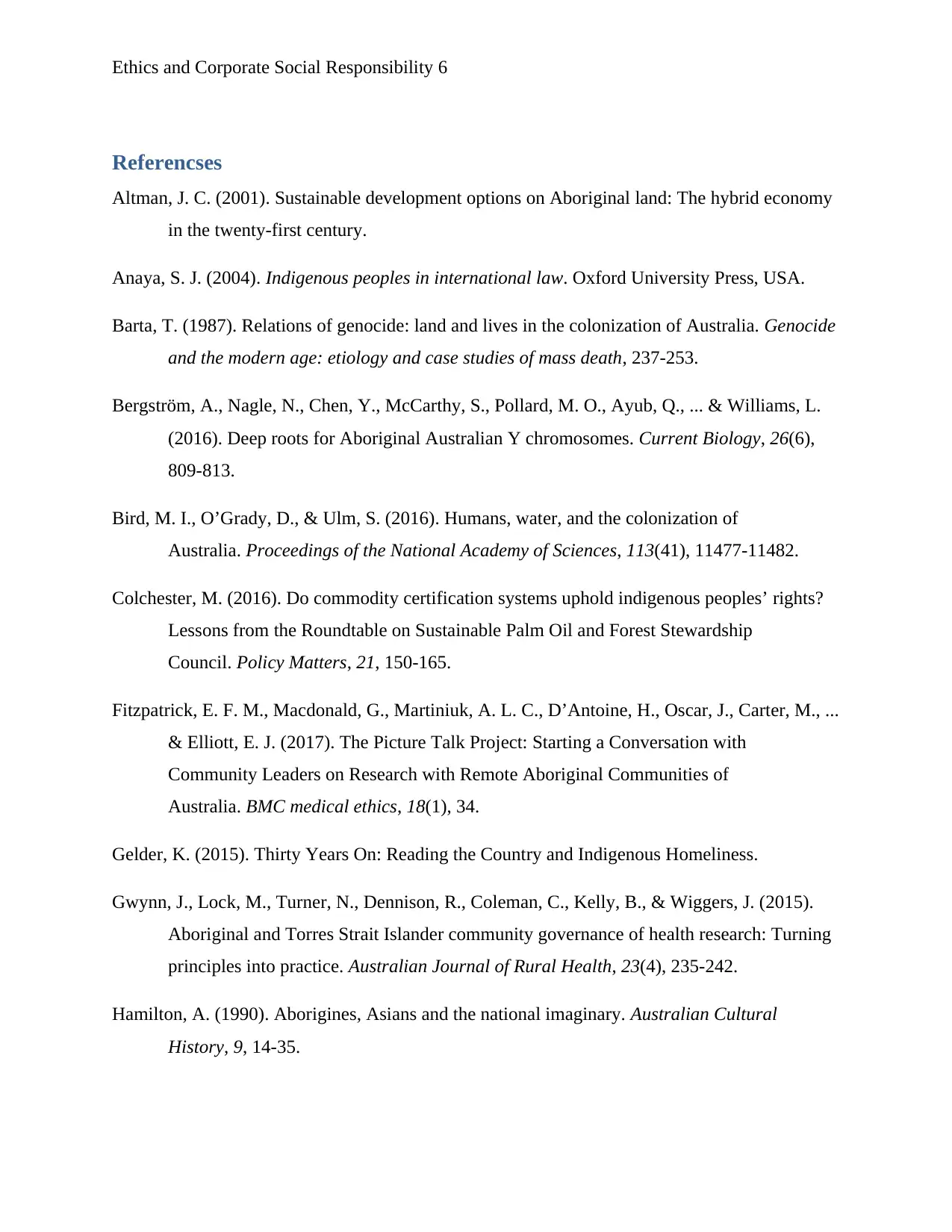
Ethics and Corporate Social Responsibility 6
Referencses
Altman, J. C. (2001). Sustainable development options on Aboriginal land: The hybrid economy
in the twenty-first century.
Anaya, S. J. (2004). Indigenous peoples in international law. Oxford University Press, USA.
Barta, T. (1987). Relations of genocide: land and lives in the colonization of Australia. Genocide
and the modern age: etiology and case studies of mass death, 237-253.
Bergström, A., Nagle, N., Chen, Y., McCarthy, S., Pollard, M. O., Ayub, Q., ... & Williams, L.
(2016). Deep roots for Aboriginal Australian Y chromosomes. Current Biology, 26(6),
809-813.
Bird, M. I., O’Grady, D., & Ulm, S. (2016). Humans, water, and the colonization of
Australia. Proceedings of the National Academy of Sciences, 113(41), 11477-11482.
Colchester, M. (2016). Do commodity certification systems uphold indigenous peoples’ rights?
Lessons from the Roundtable on Sustainable Palm Oil and Forest Stewardship
Council. Policy Matters, 21, 150-165.
Fitzpatrick, E. F. M., Macdonald, G., Martiniuk, A. L. C., D’Antoine, H., Oscar, J., Carter, M., ...
& Elliott, E. J. (2017). The Picture Talk Project: Starting a Conversation with
Community Leaders on Research with Remote Aboriginal Communities of
Australia. BMC medical ethics, 18(1), 34.
Gelder, K. (2015). Thirty Years On: Reading the Country and Indigenous Homeliness.
Gwynn, J., Lock, M., Turner, N., Dennison, R., Coleman, C., Kelly, B., & Wiggers, J. (2015).
Aboriginal and Torres Strait Islander community governance of health research: Turning
principles into practice. Australian Journal of Rural Health, 23(4), 235-242.
Hamilton, A. (1990). Aborigines, Asians and the national imaginary. Australian Cultural
History, 9, 14-35.
Referencses
Altman, J. C. (2001). Sustainable development options on Aboriginal land: The hybrid economy
in the twenty-first century.
Anaya, S. J. (2004). Indigenous peoples in international law. Oxford University Press, USA.
Barta, T. (1987). Relations of genocide: land and lives in the colonization of Australia. Genocide
and the modern age: etiology and case studies of mass death, 237-253.
Bergström, A., Nagle, N., Chen, Y., McCarthy, S., Pollard, M. O., Ayub, Q., ... & Williams, L.
(2016). Deep roots for Aboriginal Australian Y chromosomes. Current Biology, 26(6),
809-813.
Bird, M. I., O’Grady, D., & Ulm, S. (2016). Humans, water, and the colonization of
Australia. Proceedings of the National Academy of Sciences, 113(41), 11477-11482.
Colchester, M. (2016). Do commodity certification systems uphold indigenous peoples’ rights?
Lessons from the Roundtable on Sustainable Palm Oil and Forest Stewardship
Council. Policy Matters, 21, 150-165.
Fitzpatrick, E. F. M., Macdonald, G., Martiniuk, A. L. C., D’Antoine, H., Oscar, J., Carter, M., ...
& Elliott, E. J. (2017). The Picture Talk Project: Starting a Conversation with
Community Leaders on Research with Remote Aboriginal Communities of
Australia. BMC medical ethics, 18(1), 34.
Gelder, K. (2015). Thirty Years On: Reading the Country and Indigenous Homeliness.
Gwynn, J., Lock, M., Turner, N., Dennison, R., Coleman, C., Kelly, B., & Wiggers, J. (2015).
Aboriginal and Torres Strait Islander community governance of health research: Turning
principles into practice. Australian Journal of Rural Health, 23(4), 235-242.
Hamilton, A. (1990). Aborigines, Asians and the national imaginary. Australian Cultural
History, 9, 14-35.
Paraphrase This Document
Need a fresh take? Get an instant paraphrase of this document with our AI Paraphraser
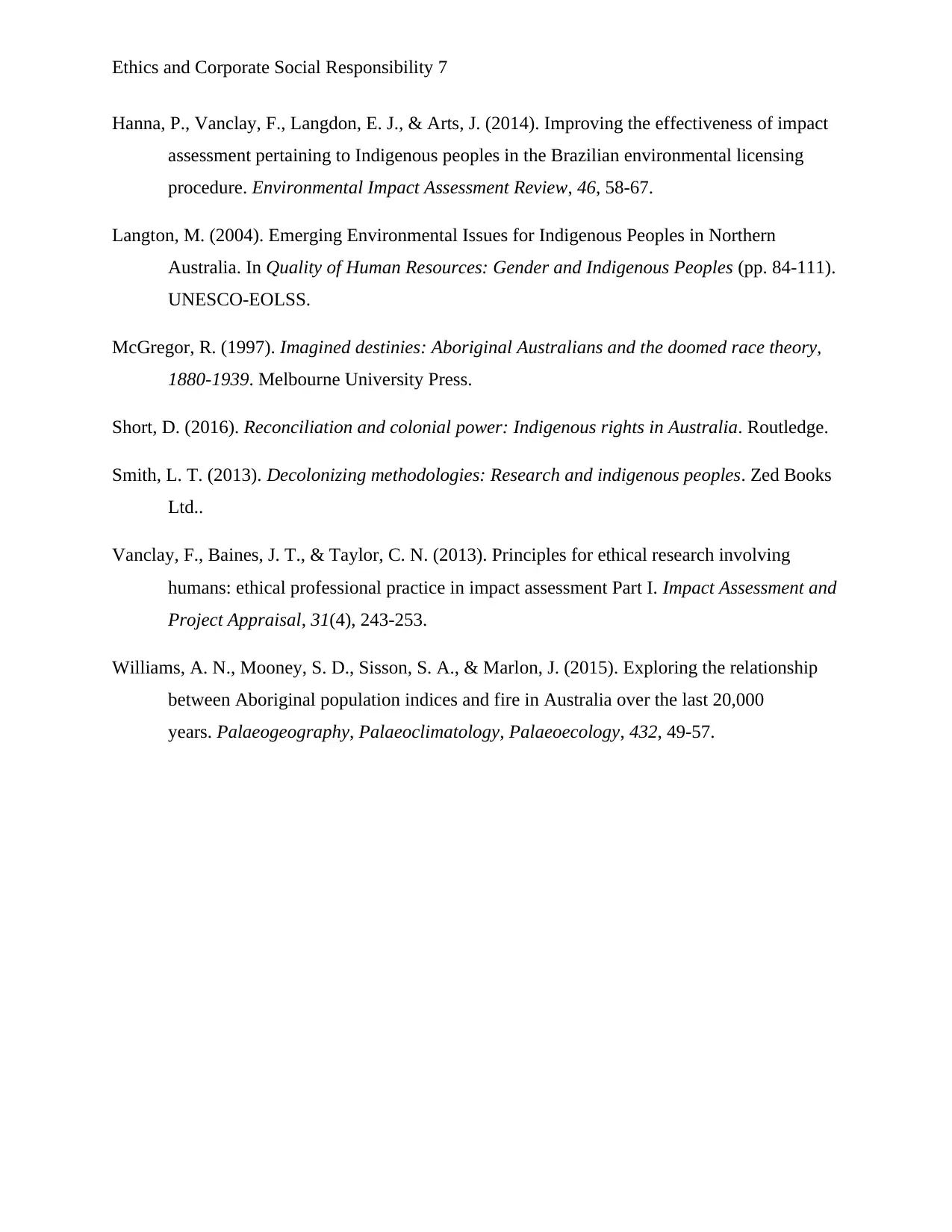
Ethics and Corporate Social Responsibility 7
Hanna, P., Vanclay, F., Langdon, E. J., & Arts, J. (2014). Improving the effectiveness of impact
assessment pertaining to Indigenous peoples in the Brazilian environmental licensing
procedure. Environmental Impact Assessment Review, 46, 58-67.
Langton, M. (2004). Emerging Environmental Issues for Indigenous Peoples in Northern
Australia. In Quality of Human Resources: Gender and Indigenous Peoples (pp. 84-111).
UNESCO-EOLSS.
McGregor, R. (1997). Imagined destinies: Aboriginal Australians and the doomed race theory,
1880-1939. Melbourne University Press.
Short, D. (2016). Reconciliation and colonial power: Indigenous rights in Australia. Routledge.
Smith, L. T. (2013). Decolonizing methodologies: Research and indigenous peoples. Zed Books
Ltd..
Vanclay, F., Baines, J. T., & Taylor, C. N. (2013). Principles for ethical research involving
humans: ethical professional practice in impact assessment Part I. Impact Assessment and
Project Appraisal, 31(4), 243-253.
Williams, A. N., Mooney, S. D., Sisson, S. A., & Marlon, J. (2015). Exploring the relationship
between Aboriginal population indices and fire in Australia over the last 20,000
years. Palaeogeography, Palaeoclimatology, Palaeoecology, 432, 49-57.
Hanna, P., Vanclay, F., Langdon, E. J., & Arts, J. (2014). Improving the effectiveness of impact
assessment pertaining to Indigenous peoples in the Brazilian environmental licensing
procedure. Environmental Impact Assessment Review, 46, 58-67.
Langton, M. (2004). Emerging Environmental Issues for Indigenous Peoples in Northern
Australia. In Quality of Human Resources: Gender and Indigenous Peoples (pp. 84-111).
UNESCO-EOLSS.
McGregor, R. (1997). Imagined destinies: Aboriginal Australians and the doomed race theory,
1880-1939. Melbourne University Press.
Short, D. (2016). Reconciliation and colonial power: Indigenous rights in Australia. Routledge.
Smith, L. T. (2013). Decolonizing methodologies: Research and indigenous peoples. Zed Books
Ltd..
Vanclay, F., Baines, J. T., & Taylor, C. N. (2013). Principles for ethical research involving
humans: ethical professional practice in impact assessment Part I. Impact Assessment and
Project Appraisal, 31(4), 243-253.
Williams, A. N., Mooney, S. D., Sisson, S. A., & Marlon, J. (2015). Exploring the relationship
between Aboriginal population indices and fire in Australia over the last 20,000
years. Palaeogeography, Palaeoclimatology, Palaeoecology, 432, 49-57.
1 out of 8
Related Documents
Your All-in-One AI-Powered Toolkit for Academic Success.
+13062052269
info@desklib.com
Available 24*7 on WhatsApp / Email
![[object Object]](/_next/static/media/star-bottom.7253800d.svg)
Unlock your academic potential
Copyright © 2020–2025 A2Z Services. All Rights Reserved. Developed and managed by ZUCOL.





